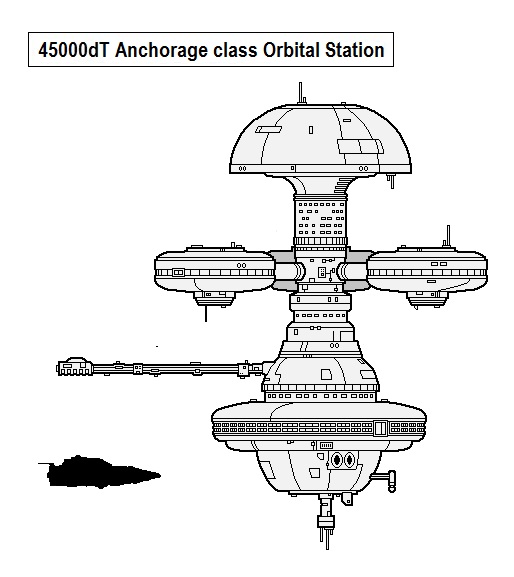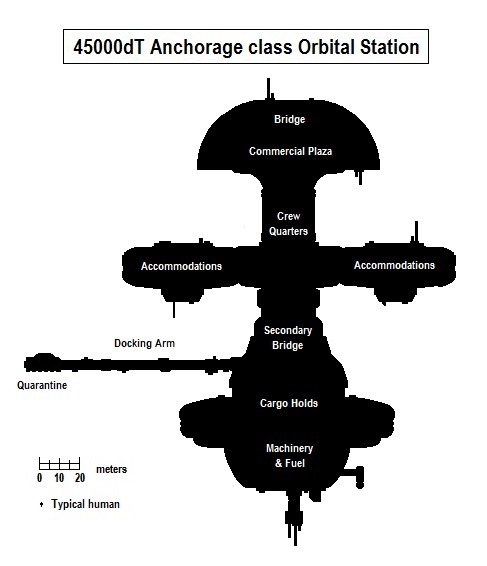Difference between revisions of "Anchorage class Orbital Station"
| Line 8: | Line 8: | ||
|canon = No. Unpublished, non-canon fan design. | |canon = No. Unpublished, non-canon fan design. | ||
|caption = [[Distant Fringe]] object. | |caption = [[Distant Fringe]] object. | ||
| − | |cargo = | + | |cargo = 12,400 |
|crew = 553 | |crew = 553 | ||
|cost = 30,060.950 (base) <br>[[MCr]]24,048.760 (qty) | |cost = 30,060.950 (base) <br>[[MCr]]24,048.760 (qty) | ||
Revision as of 17:52, 6 July 2019
| Anchorage class Orbital Station | |
|---|---|
 Distant Fringe object. | |
| Type: WO Orbital Complex | |
| Category | ACS |
| Size | 45,000 Tons |
| Hull Configuration | Close Structure Hull |
| Streamlining | Partially Streamlined Hull |
| Tech Level | TL–10 |
| Engineering | |
| Computer | Model/4 |
| Jump | J-0 |
| Maneuver | 0.5 G |
| Armaments | |
| Hardpoints | 450 |
| Accommodations | |
| Staterooms | 0 |
| Personnel | |
| Crew | 553 |
| Officers | 111 |
| Enlisted | 442 |
| High/Mid Passengers | 0 |
| Payload | |
| Cargo | 12,400 Tons |
| Fuel tank | 0 Tons |
| Construction | |
| Origin | Distant Fringe |
| Year Operational | Expansion Era |
| End of Service | Still in active service. |
| Price | |
| Cost | MCr30,060.950 (base) MCr24,048.760 (qty) |
| Architect fee | MCrCommon design: no fee is payable. |
| Statistics | |
| Quick Ship Profile | Not applicable. |
| Images | |
| Blueprint | Yes |
| Source | |
| Also see | Satellites |
| Canon | Published, fan design |
| Era | 1105 / 5600AD |
| Reference | Ade Stewart |
| Starships are designed with the Classic Traveller format, using Book 5 High Guard | |
The Anchorage class Orbital Station is a large Space Station.
- It is a Civilian Structure and an Orbital Complex.
- The station is a TL-10 design.
- Please also see AAB article: Ships of the Distant Fringe.
Description (Specifications)
The Orbital Station is a large commercial orbital facility found within systems in the Distant Fringe region. It is classified as an Orbital Complex. Similar designs have been in use from the time the Distant Fringe was first settled.
Image Repository
- An Anchorage class Orbital Station with a Wulf class Free Trader (silhouetted) alongside.

General Description & Deck Plans
- A basic plan of the station indicating the general layout and positioning of major elements.

The station is constructed as a close structure. It has five major elements - an ovoid-shaped primary hull with an outer ring surrounding it, a central column, a dome-shaped upper hull, three habitation disks mounted on arms, and a long commercial berthing arm.
The primary hull has a height of 85 meters, a maximum diameter of 70 meters, and contains 17 decks of varying heights. The outer ring has a diameter of 110 meters, a height of 20 meters and has 6 decks. The column has a height of 85 meters and contains 28 decks. The dome has a diameter of 90 meters, a height of 35 meters and contains 10 decks. The commercial arm has a length of around 100 meters and terminates in isolation and quarantine facilities. Some sections of the station are narrower and some are wider, giving it a total enclosed volume of approximately 607,500 cubic meters.
The main fuel tanks and the heavy machinery are located within the lower primary hull, while the main cargo decks are located above them and include the cryogenic (low berth) sections. A secondary control room is located at the base of the column while the main control center is located on the upper decks of the dome. General crew quarters are located within the column, though Stewards have rooms close to passenger accommodations and senior crew have accommodations close to the control centers. Middle passage accommodations are found in the less desirable central column while first class cabins occupy the habitation disks, with windows offering spectacular views. The main commercial and leisure facilities lie within the dome and are focused on a multi-deck open plaza.
Basic Ship Characteristics
Following the Imperial Navy and IISS Universal Ship Profile and data, additional information is presented in the format shown here. The small craft factor indicates the number of squadrons (...of ten subcraft) carried on the ship. Tonnage on the universal ship profile is shown in kilotons (...thousands of tons) where necessary. [1]
| Basic Ship Characteristics [2] | ||
|---|---|---|
| No. | Category | Remarks |
| 1. | Tonnage / Hull | The Orbital Station is constructed using a 45,000 dTon hull built in a close structure configuration. The hull is unstreamlined and cannot survive entry into a planetary atmosphere.
|
| 2. | Crew | Total Crew Complement: 553
Accommodations:
There are x400 Low Berths. The low berths are overseen by the station's medical staff, assisted by properly trained service crew. Accessible areas of the hull are fitted with grav plates and inertial compensators and have full life support and environmental systems.
|
| 3. | Performance | The station mounts a Maneuver half-drive, and a Power Plant-1, giving performance of 0.5-G acceleration (sufficient for orbital positioning only) and producing 450 Energy Points. The station does not have an agility rating. The dedicated internal fuel tankage gives the power plant 4 weeks duration.
|
| 4. | Electronics | Adjacent to the bridge is a Model/4 Computer: the station has x2 backup Model/4 Computers.
|
| 5. | Hardpoints | x450 hardpoints.
|
| 6. | Armament | x5 100-Ton bays, mounting Heavy Missile Launchers.
x100 triple Beam Laser turrets, grouped into ten batteries of 10 linked turrets. |
| 7. | Defenses | The hull is unarmored.
x300 triple Sandcaster turrets, typically grouped into thirty batteries of 10 linked turrets. The station is not fitted with screens or other passive defensive systems. |
| 8. | Craft | The station is not supplied with intrinsic subcraft: these are purchased as required by the station's operators.
Hangars |
| 9. | Fuel Treatment | The station has internal fuel tankage of 3,500 dTons.
|
| 10. | Cost | The basic cost of the station is MCr30,060.950
|
| 11. | Construction Time | 189 weeks (47 months) as standard.
|
| 12. | Comments | Standard cargo capacity amounts to 12,400 dTons.
|
History & Background (Dossier)
Anchorage class Orbital Stations are rugged and known for their excellent safety record. Many are finished to very high standards, offering services and facilities equivalent to surface hotels, leisure complexes and shopping malls, but with the additional benefit that they are free of any local taxes and surcharges. The design is representative and a large number of variants exist, particularly with regard to the allotted weapons systems, onboard electronics, and the fit out of internal spaces.
Support Craft
The station relies on a variety of support craft.
Interface Craft:
Tankers:
Distant Fringe Vessels
The Distant Fringe is said to be a far spinward-rimward area inhabited by colonists and refugees originating on Terra. The region is extremely isolated, separated from the rest of Charted Space by vast, almost uncrossable rifts that were once broached by a system of calibration Points and the use of tankers. Those few academics within Charted Space who have found references to the Distant Fringe regard it as little more than a tall tale. Likewise, many of the inhabitants of the Distant Fringe believe the existence of Charted Space to be mythical.[3]
Vessels originating within the Distant Fringe are very rarely encountered outside of the region. However, misjumps do occur and anomalies with bizarre spacetime and Jumpspace effects exist: as such, craft of this type are not entirely unknown within Charted Space.[4]
Class Naming Practice/s & Peculiarities
A number of companies manufacture facilities equivalent to the Anchorage class Station.
They vary in hull shape and internal layout but all share the same basic design and all have very similar capabilities and performance characteristics
- Each variant class of yard is named by the company that produces it: these organizations generally draw on traditional naming protocols. It is not uncommon for a historical class name to be reused.
- Individual stations within a class are issued specific designations.
Selected Variant Types & Classes
Artificial Satellites – Space Stations:
References & Contributors (Sources)
| This article has metadata. |
| This article is missing content for one or more detailed sections. Additional details are required to complete the article. You can help the Traveller Wiki by expanding it. |
- Marc Miller, Frank Chadwick, John Harshman. High Guard (Game Designers Workshop, 1980), 20-37. (Design Sequence Used)
- Traveller Wiki Editorial Team
- Author & Contributor: Lord (Marquis) and Master Scout Emeritus Adie Alegoric Stewart of the IISS
- Author & Contributor: Lord (Marquis) and Master of Sophontology Maksim-Smelchak of the Ministry of Science
- ↑ Timothy B. Brown. Fighting Ships (Game Designers Workshop, 1981), 10.
- ↑ Timothy B. Brown. Fighting Ships (Game Designers Workshop, 1981), 10.
- ↑ Information provided to the library by Maksim-Smelchak
- ↑ Information provided to the library by Maksim-Smelchak